$Associate Professor and Extension Specialist, CMNS, Department of Entomology
*Assistant Professor, CMNS, Department of Entomology. Twitter: @Analyssi
Note: This is the sixth article of our series on pollinators. The initial articles can be found in the vegetable and fruit headline news June, July and August special editions and Maryland Agronomy News Blog.
Introduction
Ants (Hymenoptera: Formicidae) are among the most evolutionarily successful insect groups. They are prevalent numerically, geographically and ecologically, and subsequently have an extreme impact on the various ecosystems that they inhabit. Ants are the largest insect family in terms of species diversity and sheer number of individuals. More than 15,000 species of ants are known globally. Though they are notoriously recognized as generalist foragers, some ant species regularly visit flowers (Fig. 1). Similar to numerous other insects, ants enjoy eating energy-rich nectar and frequently visit angiosperms flowers. Further, ants are close relatives of other hymenopterans (bees and wasps) which are important pollinators in most plant communities. However, comparative to their relatives, ants are mostly minor pollinators and can even have an antagonistic relationship with flowers. It can be at first viewed surprisingly that the number of ant-pollinated plants is low considering their abundance, the fact that they can carry pollen, and that they commonly visit flowers. Though two thirds of all angiosperms are pollinated by insects, roughly 30 reports suggest pollination by ants. However, this may be an overestimation, as experiments have not been conducted to confirm ant pollination in all reported cases. Ant pollination is thus rare and restricted to a few species within different families of angiosperms. Several reasons have been proposed to why ants are poor and rare pollinators. One is that due to their small size, ants can extract nectar without touching the reproductive organs of flowers, thus not contributing to pollination and consequently acting more like nectar robbers than pollinators. Another reason lies in the morphology and chemical characteristics of the body surface of ants. Their bodies are smooth and hairless making it hard for pollen to attach to ants. Further, their body surface secretes antibiotics secretions, which have been shown to reduce the viability of pollen grains. Moreover, their mandibles are not ideal for nectar collection, and are rather destructive to flower parts. Although ants are rarely considered true pollinators, there are instances where they can serve as pollen vectors as well as contribute to other ecosystem services through other mutualistic interactions with plants.
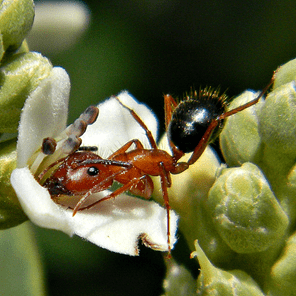
Ants importance as pollinators
Many ants visit flowers that are also visited by other insect pollinators (Fig. 2). When doing so, and depending on the floral morphology, pollen grains can attach to their bodies. However, for reasons stated above, their contribution to pollination is not remotely as important as other invertebrate pollinators such as beetles, flies, butterflies and moths. Relative to this, ants are not considered important pollinators and ant pollinators are believed to be extremely rare. However, ants may play a role in pollination under a limited set of circumstances such as in situations where smaller plants (epiphytes or annual herbs) occur in high density. For example, the knotweed Polygonum cascadense, a small, apparently self-incompatible annual, was determined to be regularly cross-pollinated by the ant, Formica argentea (Figs. 3a, b). Ant pollination may also be essential when more effective winged pollinators are scarce and ants contribute to enhance self-pollination such as in arid or alpine environments. Further, there are situations where pollination by ants are comparative to that of bees. For instance, studies indicated that ants significantly contribute to seed set of the shrub Conospermum undulatum. Further, pollen of this and other Conospermum species have a germination rate of ~80% after contact with ants, which equals that of bees. This is relevant because these investigations showed that other plant species showed a significant reduction in germination rate (to about 10%) following ant exposure. This indicates that the pollen of Conospermum is resistant to the ant’s antibiotic secretions. Given this, it is likely that Conospermum has evolved to become successfully pollinated by ants.
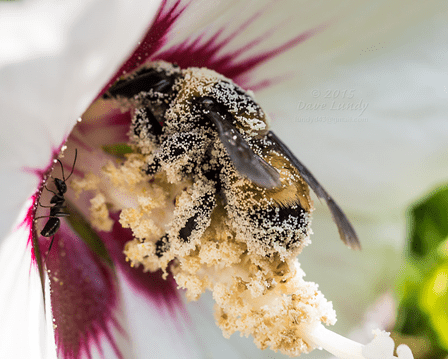
There are instances where pollen exhibits reduced germination after ant exposure, yet the abundance of ant visitation leads to increased number of viable seeds in plants that they visit. In this case, the loss in pollen germination is made up by the frequency and number of flower visits. This is the case for worker ants (Proformica longiseta). In a study of the flowering woody plant Hormathophylla spinosa, even though flowers were visited by 38 species of winged insects, worker ants maintained the strongest mutualistic interaction. The key factor was thought to be the large crowd of workers visiting H. spinosa throughout its flowering period. In relation to this, it is important to realize that ants being social insects, individual colonies can contain millions of members, which have the potential to increase floral visits to extraordinary numbers. Thus, floral visit inefficiencies can be made up with large number of visits.
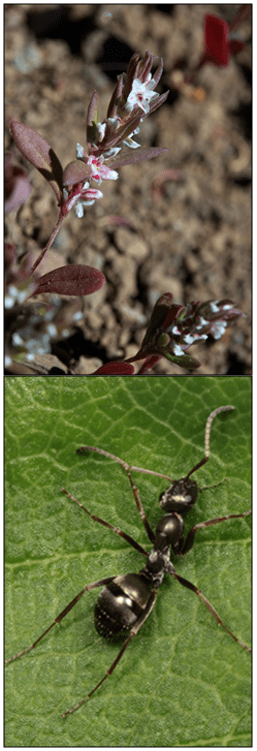
Ant pollination traits
Ant-pollination syndrome may be defined as flower characteristics or traits that are associated with ant pollination. Common traits of ant pollination include low-growing or small plants that occur in high density or in groups, and mostly prostrate in growth form with closely intertwined branches. Flowers are generally small and brightly colored, or white with an open structure that grants access to floral nectar. Ants also seem to be attracted to inconspicuous and sessile flowers that are low-growing, positioned close to the stem, and exhibit minimal attractions. Ant pollinated flowers also have relatively few ovules, which may all be pollinated by compendious pollen deliveries. Ant flowers produce small amounts of sticky pollen grains so as to not stimulate self-grooming which removes pollen load, and to effectively attach to the often-smooth ant body surface. Similarly, nectaries are small and morphologically available to flightless ant workers, and produce low quantity of nectar so that larger insects are not interested. Ant plants often contain overlapping inflorescences at a uniform height, and low seed number per flower, which requires reduced pollen transfer.
Most plants displaying ant‐pollination syndromes appear to occur in hot and dry, or alpine habitats where ants are abundant and active. Examples include plant species occurring on the hot dry slope of the western Cascades of Oregon, granite outcrops of the southeastern US and the Colorado alpine tundra. Some examples of ant-pollinated plants in North America include the small’s stonecrop (Diamorpha smallii), the alpine nailwort (Paronychia pulvinata) and the Cascade knotweed (Polygonum cascadense; Fig. 3a). Ants were also shown to be significant pollinators of two orchid species (Chamor-chis alpine and Dactylorhiza viridis) in the alpine zone of the Alps. Speaking of orchids and ants, the Australian orchid, Leporella fimbriata is pollinated via pseudocopulation. In this case, a male ant is attracted to the flower, which visually and chemically resembles the female of the ant species. Once the male lands on the flower, he tries to mate, and while doing so he unwillingly receives and transfers pollen. In the case of L. fimbriata, winged males of the bulldog ant genus Myrmecia mistaken these flowers for virgin queens and attempt to mate with them, picking up pollen in the process (Fig. 4).

Why are ants inefficient at pollination?
Biochemistry. Ants usually live underground in humid conditions, and often in association with fungal and bacterial colonies that they actively cultivate and tend to. To avoid being exposed to infections, ants and their larvae secrete antibiotic materials to suppress bacterial and fungal growth on their bodies. These secretions have been shown to interfere with pollen germination, by killing pollen grains that come in contact with ant secretions while they are foraging. Because antibiotic production is central to ant survival, the evolution of this disease resistance trait in ancestral ants may have limited the ability of ant pollination to evolve broadly among flowering plants.
Body traits. Ants are usually small, especially compared to alternative insect pollinators. This small size reduces the amount of pollen an individual ant is able to carry. Moreover, their diminutive stature allows them to avoid contact with anthers and stigmas while getting nectar from flowers, and at least in some ant species, pollen may not be able to properly adhere to their hard and generally smooth bodies. Even though this is the case for most ant species, many others can be as hairy as bees, or are covered with bristles suitable for carrying pollen.
Behavior. Ants may interfere with pollination by damaging plants’ reproductive organs with their large mandibles, and by removing pollen from their body while self-cleaning. Ants may also be more attractive to extrafloral nectar of plants as opposed to their flowers. However, it is probable that plants lure ants towards their extrafloral nectaries in part to prevent them from damaging their flowers (Fig. 5). Extrafloral nectaries are nectar-secreting organs, which supply insects with carbohydrates while maintaining them away from the reproductive organs. In the case of ants, it is possible that this organ evolved to distract ants from flowers, and to attract worker ants who function as bodyguards for these plants. It has been also suggested that the wingless ant workers who visit many flowers are unable to carry pollen far enough for outcrossing, since they continuously revisit the same plant for nectar. Relative to this, a large majority of ant-pollinated plants are self-compatible (capable of self-fertilization) and are thus less affected by geitonogamy (pollination of a flower by pollen from another flower on the same plant). This indicates that the evolution of ants as pollinators may have been only (or mostly) possible in plants that do not require long-distance pollen dispersal.
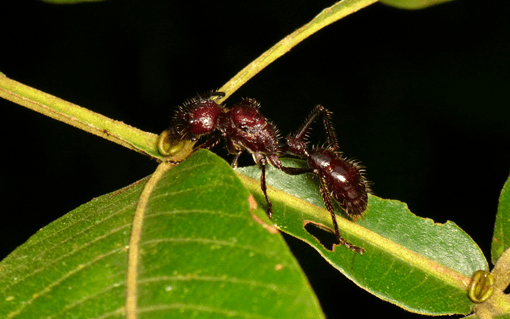
Plant defenses. Ants are more popularly known as nectar thieves or robbers. This is because they remove nectar from plants without effectively pollinating their flowers. Because of their thieving nature and the potential damage that they can cause to flowers, numerous plants have evolved barriers to exclude ants from their floral rewards, such as dense fields of hairs or sticky bands inside their corolla. Some plants also employ ant-deterrent mechanisms to prevent disruption of pollination. These mechanisms include morphological features that promote ant and floral spatial segregation or ant-repellent volatile compounds in petals and/or pollen. As such, repellency of floral parts, sticky tissues and glandular hairs may further limit ant’s access to flowers.
Negative floral visitation costs
In addition to pollination failure, floral visitation by ants can result in several other non-positive outcomes. Their visits may result in damaged floral structures, reduced pollen viability, avoidance by other pollinators in response to ants and their olfactory cues, and exploitation or alteration of floral resources. Further, floral visitation by ants can reduce plant reproduction success in situations where ants harass and interfere with more effective pollinators. Relative to this, a study was conducted to examine the importance of floral visitation by the non-native Argentine ant (Linepithema humile) on island morning glory (Calystegia macrostegia ssp. macrostegia). The Argentine ants often behaved aggressively towards other floral visitors. Consequently, their presence in morning glory flowers disrupted pollination services by decreasing floral visitor diversity, bee visitation rates and pollen levels. In other situations, honeydew‐producing insects such as aphids, scales and mealybugs may alter the activity and density of ants on plants, which, in turn, can disrupt pollination services. Ants feed on honeydew produced by these insects and in turn protect them from their natural enemies and impede visitation by true pollinators. Pertinent to this, another study involving Argentine ants was conducted in which the number of cotton aphids, Aphis gossypii was manipulated on cotton (Gossypium hirsutum) plants. The study showed that increasing aphid numbers enhanced ant abundance on cotton plants and their floral visitation. Consequently, the duration of visits by honey bees and seed production declined as a result. These studies illustrate that ants can intimidate pollinators, interfere with pollination and subsequently abate plant reproduction.
Other ant services to plants
Plant visitation by ants can in some circumstances benefit plants. In addition to rare cases involving ant‐mediated pollination, ants may interact with other floral visitors in ways that deter ineffective floral visitors in favor of effective pollinators, or potentially enhance the male component of plant fitness by increasing pollen transfer. Further, though ant’s contribution to pollination services is minimal, there are two other central ecosystems services that they contribute to in plants: seed dispersal and plant protection.
Seed dispersal – Ants play a key role in seed dispersal in many ecosystems and there are numerous ant species that remove and transport seeds. Seed dispersal by ants (myrmecochory) is a global driver of plant diversity and population dynamics. Myrmecochorous plants dominate communities in many habitats, and are characterized by the presence of a lipid-rich structure (the elaiosome) that is particularly attractive to ants. Though, long-distance seed dispersal can occur via ants, they generally disperse seeds only short distances to their nests, where they remove the elaiosome to feed it to their larvae. Until today, elaiosomes have been found in over 11,000 plant species across 77 flowering plant families. Similar to pollinators, seed dispersers are essential to plant diversification and colonization of new habitats. To this point, myrmecochorous dispersal is a reliable means of seed propagation. Myrmecochory allows plants to increase their area of distribution and success at progeny establishment.
Plant protection – Through mutualistic interactions, ants help protect plants from being eaten by insect and vertebrate herbivores. In these cases, plants rely on the defensive capabilities of ants to protect them from insects, including nectar robbers. In this type of interaction, the ants receive access to a high-quality food source, while the plant receives protection against herbivore colonization and feeding. Ants may also prune climbing vines and prevent fungal and microbial infestation on plant tissues. Thus, the establishment of this mutualistic interaction enhances the reproductive success of plants with extrafloral nectaries, and this strategy has thus evolved multiple times throughout the history of flowering plants. In order to protect the nectar source, ants attracted to extrafloral nectaries are usually defensive against other plant visitors. Further, it has been shown that the larger the value of the extrafloral nectar to ants, the greater their aggressiveness toward herbivores. To this point, some ant body guards may even consume herbivorous arthropods that they encounter on plants; and it has been shown that some ant species can reduce crop pest numbers and their damage, resulting in greater crop yields. Indeed, because of their large numbers, ants have the capability to rapidly consume large number of insect pests. It has been suggested that their efficiency as pest suppressors is comparable to chemical pesticides or higher, while at lower economic and environmental costs. To this point, ant predation contributes to the natural suppression of economically important insect pests. An example of this is weaver ants of the genus Oecophylla, where it has been shown that they can be highly efficient biological control agents (Fig. 6).
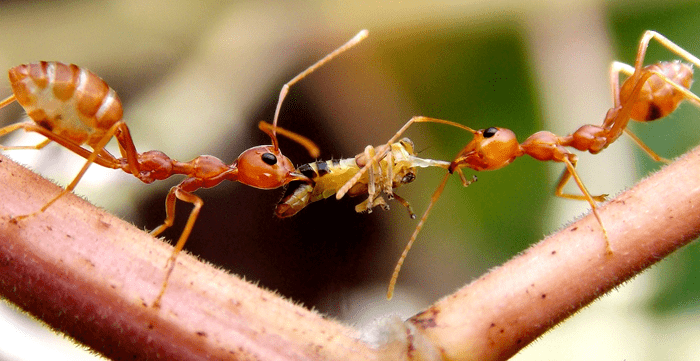
Summary
Ant-plant associations are immensely diverse and present globally, leading to both mutualistic and/or antagonistic interactions. Regarding ant–plant mutualism, ant pollination is considered to occur with rarity and few studies have explicitly explored ants’ roles as pollinators. Ants, unlike other insect pollinators have several impediments such as limited foraging distances as most are wingless, and they produce body secretions that reduce pollen viability. Though ant-pollination is insignificant when compared to other invertebrate pollinators, there are instances where other pollinators are absent or scarce such as in alpine and arid conditions, where plants rely on foraging worker ants for reproduction. Along with pollination, ants play a key role in seed dispersal in thousands of plant species, which is key to plant diversification and colonization of new habitats. Last but not least, ants are also capable of protecting plants from herbivory and expelling nectar thieves, which is many times facilitated and promoted by the presence of extrafloral nectaries. This leads to higher reproductive success and fitness, which in the case of economically important plants is reflected in greater yields and enhanced crop quality.
Financial support for the publication of this article is via USDA NIFA EIPM grant award numbers 2017-70006-27171.
